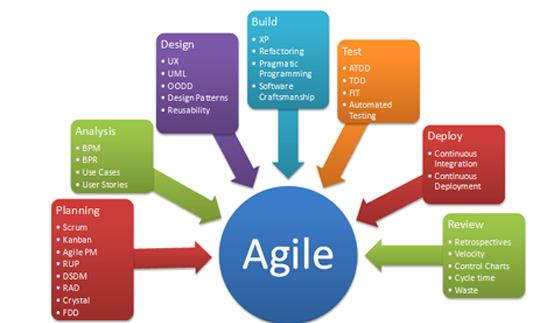Eight tricks that marketers can borrow from Agile programmers
 In search of new ideas for organizing work, we stumbled upon an interesting article from Matthew Stibb, CEO of Articulate Marketing . The idea seemed interesting to us, and we decided to share it with our readers.
In search of new ideas for organizing work, we stumbled upon an interesting article from Matthew Stibb, CEO of Articulate Marketing . The idea seemed interesting to us, and we decided to share it with our readers.Matthew spent more than ten years developing computer games, and now manages a marketing agency that works in the field of content and online business applications.
')
Agile programming is a relatively new approach to software development. This technique allows the intense and sometimes unpredictable software development process to turn into a manageable, well-planned and teamwork. This is exactly what Stibb proposes to do with the work of marketers, that is, to take advantage of flexible programming models in preparing marketing content.

1. Pair programming
This approach involves the work of programmers in a pair. Employees perform two tasks: writing code and controlling the overall picture, while workers are interchangeable. Articulate Marketing uses the same trick. Two experts are assigned to write an interview or article: one writes the text, and the second makes edits. Often changing roles to perform different parts of the task.

2. Flow and regression testing
In a flexible programming model, every change made to the code is followed by an update of the automated test result to ensure that the changes do not violate the software robot. In marketing, especially in internet marketing, this approach helps to evaluate the effectiveness of your every action. Does this page bring more conversion than the previous one? Is the new CTA (Call To Action) effective? And so on. But the idea of regression testing also means the following: what works today needs constant monitoring to make sure that it will still work tomorrow.
3. Planning
Agile developers don't like overtime. It is not accepted to write until night, drinking tons of coffee, and eat, not looking up from work. Instead, they plan their work on the basis of an intensive 40-hour work week. Marketers must do the same, even if it means saying no to unexpected customer deadlines. As stated in Texas, “the lack of planning on your part does not constitute an emergency on my part.” In the end, emergency work reduces productivity and leads to a drop in quality.
4. Opinion of users, but not technical characteristics
Agile programmers and managers do not hide from the user behind the jumble of code, they do not wave off the specification and do not try to protect themselves from the customer. Instead, they offer the client to cooperate with them and describe his vision of the final result. Marketers can use a similar approach, assessing the style, originality and topic of the article, and not the time it takes to write it. Articulate Marketing does not use time sheets, but evaluates the final result.
5. “Much” does not always mean “long”
One of the agile development tools - Pivotal Tracker uses an approach that differs from the traditional one. Instead of predicting the time to complete a task, the developer estimates its complexity from 1 to 3 and notes its level of importance in the context of other tasks. Over time, the service analyzes the work of the contractor and can calculate the estimated time of the execution of a task. Articulate Marketing uses a similar system to plan and control task execution.
6. “Stand up” meetings

Instead of endlessly holding meetings and conference calls, developers hold “stand up” meetings at the beginning of the week to exchange information and discuss projects. Articulate Marketing is doing exactly the same. And, as the name implies, when people are standing, they try to speak as little as possible and on business!
7. Consider changes, not ignore them.
Most projects are limited to a rigid specification, which is inherent in their foundation. This approach causes two problems: the client does not know how satisfied the product is until he sees it; during long periods of project creation, it may lose relevance even before its completion. Agility encourages customer participation in the design phase and assumes that the project will change over time. In Articulate Marketing, this approach is implemented through constant feedback and content editing. Perhaps this is not quite satisfied with the author, but provides high-performance products for customers.
8. Sprint, not marathons
Creating computer games takes considerable time, and the team cannot be sure of success until the project reaches the final stage. Agile developers use a different approach, seeking to create a workable service with minimal resources, gradually optimizing and developing it, taking into account the needs of users. The project, divided into several short stages, is easier to adapt to changes in requirements and circumstances. This method is great for marketing projects. The advertising company really does not end as long as the product exists, and the site must constantly evolve.
Summing up, we want to emphasize that Agile-development helps to create projects that take into account the dynamic environment, which is vital for marketing processes. You cannot afford to rest on the laurels of one successful project or its stage. You must constantly change, adapt and closely monitor what is happening.
Original article: www.marketingprofs.com/articles/2014/24750/eight-secrets-of-agile-marketing
Source: https://habr.com/ru/post/217965/
All Articles